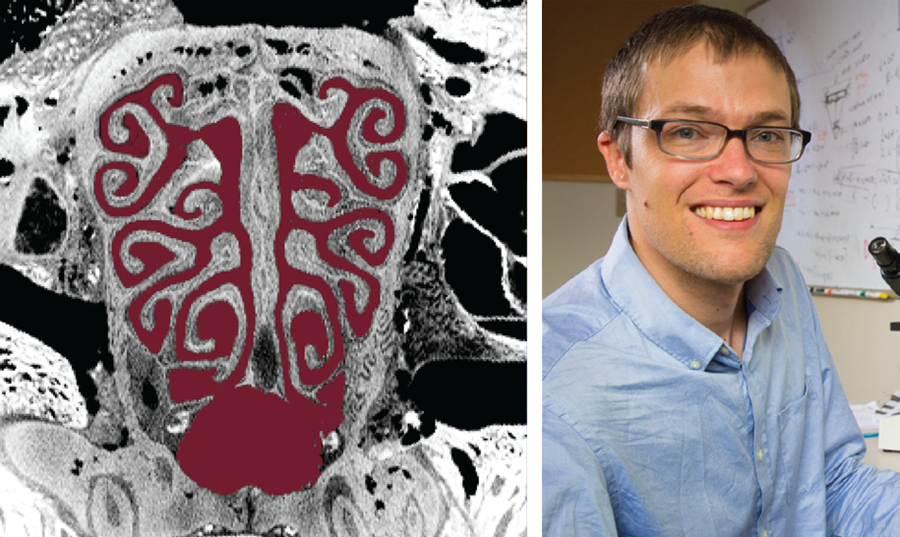NSF Funds Study of How the Brain Encodes Smells and Flavors

On left, an image of a rat nasal cavity in cross section, acquired using microCT imaging. Right: Woodrow Shew, associate professor of physics.
How do our brain, nose, and mouth work together to generate the flavor of food and drink? When flavor perception goes wrong, can this play a role in diseases like obesity?
The sense of smell is very important for perceiving flavor, largely because of odors that originate in the mouth and are exhaled through the nose via the back of the throat in a process called retronasal olfaction. However, the detailed mechanisms of how retronasal odors get encoded in the brain are poorly understood. The Shew Lab at University of Arkansas has put together a team from across the United States to study these phenomena. The National Science Foundation has funded the research with a total of $923,000 over three years, more than half of which will fund the U of A part of the team.
The researchers combine direct measurements of the brain in action together with computer simulations of air flow through the nose and neural networks. They are testing the idea that different forces in the nose caused by reversing airflow through the nasal cavity are responsible for how the brain distinguishes exhaled retronasal odors from inhaled odors. The research will heavily involve students and will also develop an educational video game together with UA Tesseract Center aimed at introducing players to basic concepts of neurobiology and cognitive neuroscience.
Experiments done at the University of Arkansas will be lead by associate professor Woodrow Shew and postdoctoral fellow Shree Gautam. Shew and Gautam are in the Department of Physics and affiliated with the UA Integrative Systems Neuroscience group.
To gain deeper insight on the experiments, computer model neural networks will be developed by Cheng Ly, an associate professor in the Department of Statistical Sciences and Operations Research at Virginia Commonwealth University. Additional computer simulations of air flow through the nasal cavity (see picture) will be done by Andrea Bareiro, an assistant professor of mathematics at Southern Methodist University. The complex structure of the nasal cavity will be precisely determined using the facilities of the recently established microCT Imaging Consortium for Research and Outreach at the U of A.
Topics
Contacts
Woodrow Shew, associate professor
Department of Physics
479-422-9882,
woodrowshew@gmail.com
Headlines
Four Students Named Goldwater Scholars; Two Earn Udall Honorable Mentions
Four U of A students have received the prestigious Goldwater Scholarship, an award for top students in mathematics, science, and engineering.
Cross-Campus Collaboration Culminates in New Outdoor Geological Installation
Grand opening event to celebrate the new GeoLab installation at the U of A’s Gearhart Hall courtyard is set for May 3. The installation will be open to the public year-round.
First Students to Use Online Degree to Hone Nursing Leadership, Elevate Patient Care
Hanna Baxendale and Wendi Kimbrell will begin coursework in the Doctor of Nursing Practice-Executive Master of Business Administration program offered by the Eleanor Mann School of Nursing and Walton College.
Join the Office for Sustainability on a Final Cruise to Campus
Cruise to Campus Wednesdays have fostered a gathering space for individuals interested in biking to campus. Drop by the Old Main Lawn from 7:30-10 a.m. Wednesday for coffee, something to eat and conversation.
Fay Jones School Student Ambassador Program Gives Voice to Design Students
The student ambassador program at the Fay Jones School of Architecture and Design is built to connect top design students with their school, its alumni, its future students and others inside and outside the school.




